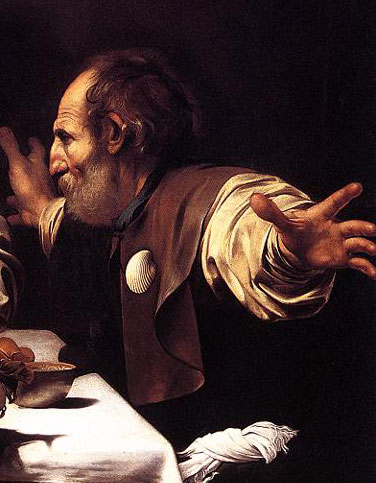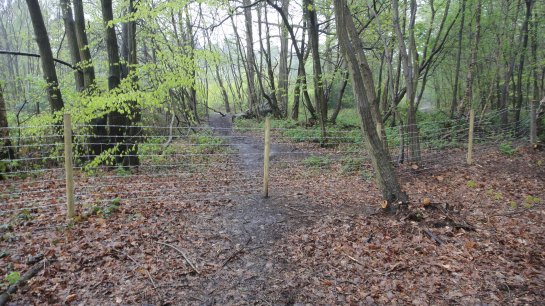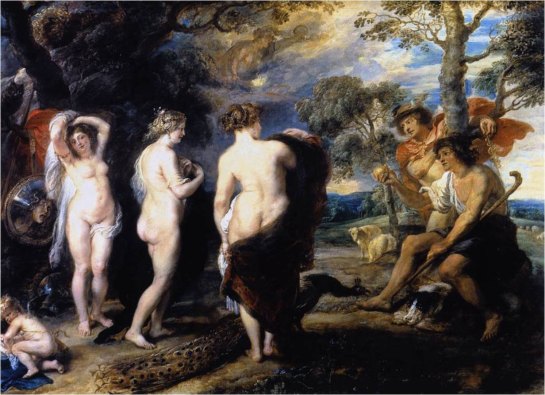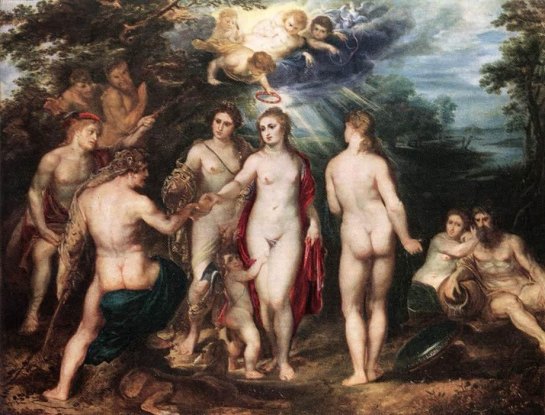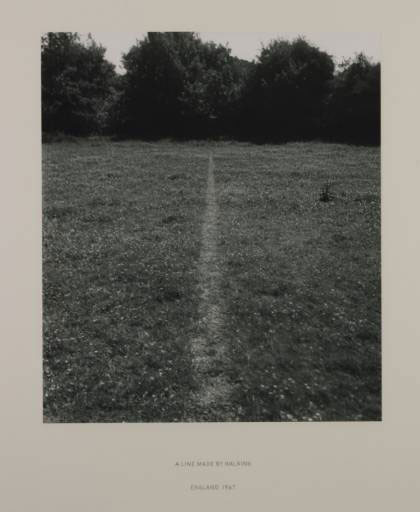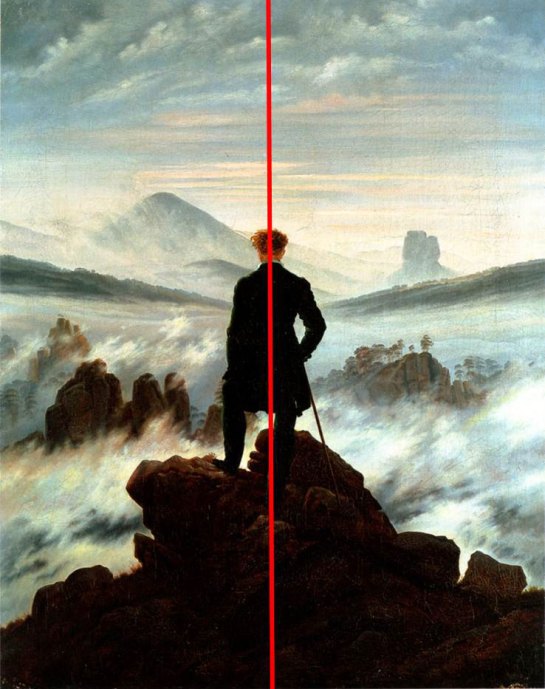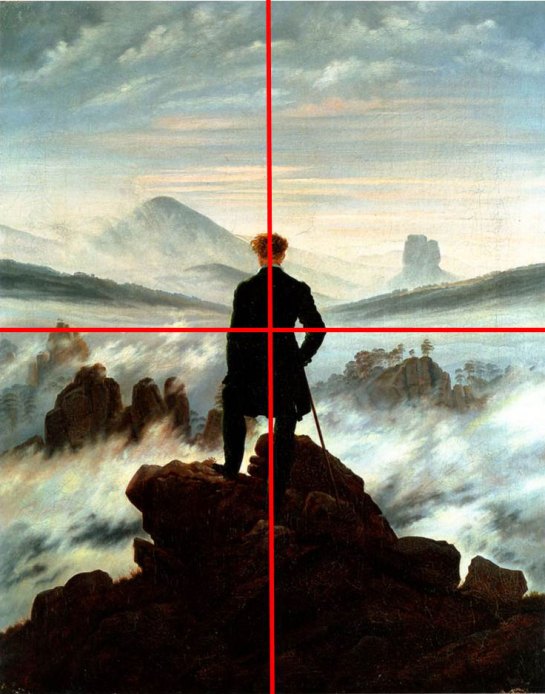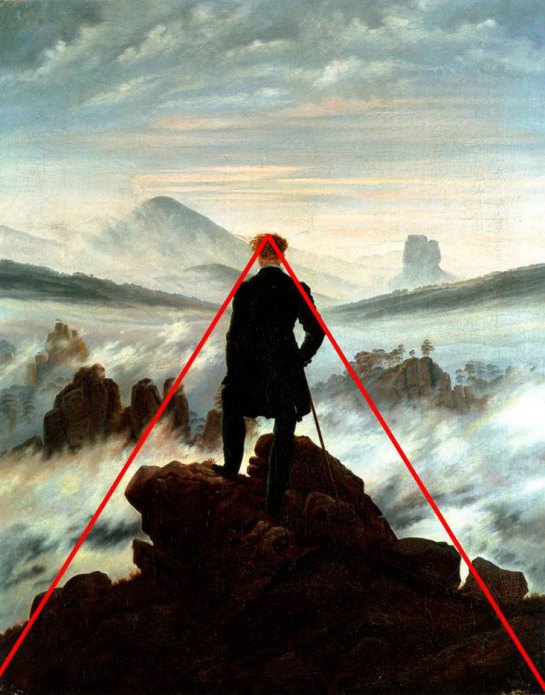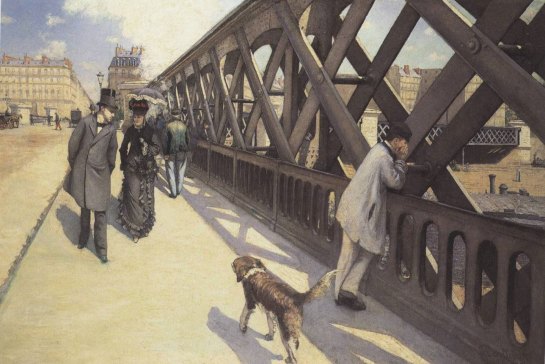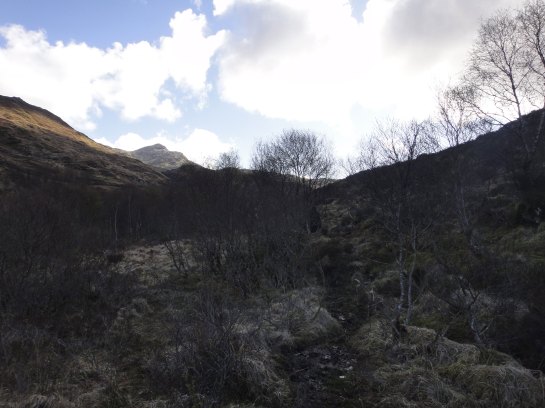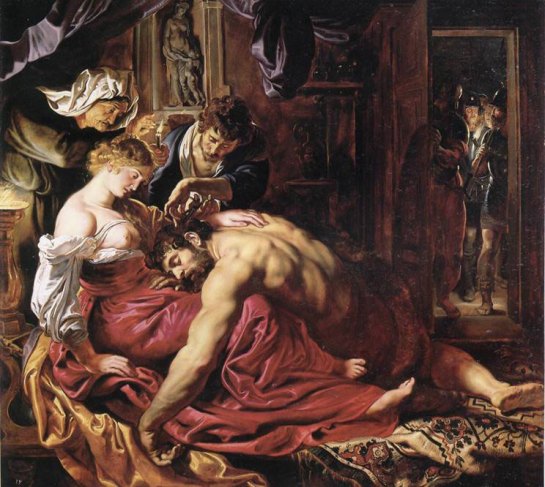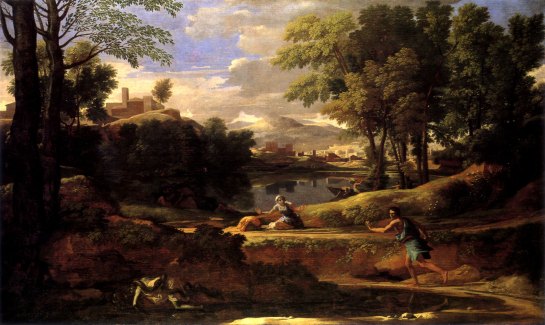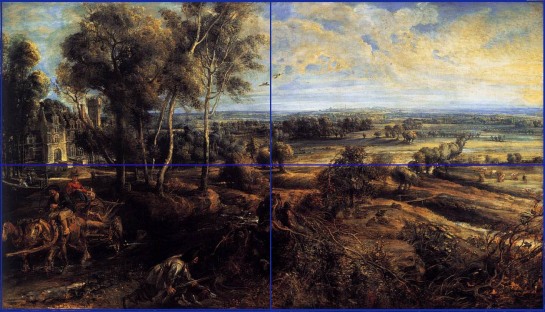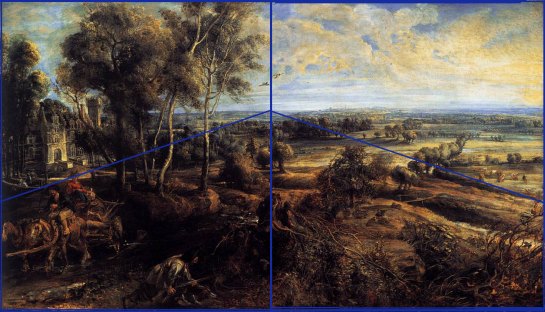A young man is unhappy, as he speaks into his phone I gather that he has left his tent on the train; he is carrying two large rucksacks. He was expecting to sleep in the tent which must, by now, be half way to Ramsgate. It is late Friday afternoon on a small, rural station, the ticket office is closed. He had not obeyed the constant instruction:
“TAKE ALL OF YOUR PERSONAL BELONGINGS WITH YOU WHEN YOU ALIGHT AT YOUR NEXT STATION STOP”
Sympathy for the poor man without his weekend shelter prompts thoughts about our minimum requirements; what are the key elements of ‘home’? Do we always carry ‘home’ with us?
National Schools?
I have just come from a talk by the President of the Royal Academy to a group of schoolchildren. I had been about a National School of Art, a founding function of the Royal Academy. Afterwards a GCSE student asked the Pres about Tracey Emin, he was very appreciative of her time and commitment. He did not discuss whether she was, in fact, part of the new National School he was supposed to promote. Is such a collection possible or desirable in a complex, multicultural world? ‘National’ presumes a homogenous culture, a shared view of the land we share. We all share the same sky as the old posters used to say, appreciation of soft, British light might characterise those who struggle to represent its landscape.
National Characteristics: Light
It is grey and cold and drizzling on the platform, the light levels are low. Two girls are standing, half way along, towards the front. They face each other and bob slowly up and down in exact time, knees not quite touching. Just before the train arrives, the sun briefly appears on the horizon, it silhouettes the two gently rising and falling figures
What else might allow us to think of home as a set of shared national characteristics?
National Characteristics: Channelling your inner minor official
Time on public transport brings to mind that national inability to operate or cope with minor authority. Give any British man or woman a cap, a radio, a low level position of importance and we become instantly unbearable, we suppress individuality and joy in ourselves and others. That overwhelming British urge to stop someone enjoying themselves. Is that a recognisable icon on our national desktop?
This morning, on the bus, the new driver did not know the way. The driver made it as clear as he could that it was the passengers fault, we in turn did not help, did not show him where to go. He was lost and grumpy in charge of a double decker bus on winding country lanes; we were on a rudderless ship.
National Characteristics: Making it Big
As I watch the tent-less man, I can see another familiar theme on the pull down menu; sat on a bench is a young man on his mobile. He wears a vivid red and white shiny tracksuit and a crisp, purple New York Yankees baseball cap, the price ticket in dollars proudly displayed. His accent though is clearly local as he continues a monologue about his sexual successes. Could such a fidgety, awkward youth, blessed with such poor, pale skin expect his listeners to believe his spectacular history?
St Jerome
A small painting in the National Gallery shows a different conceptual desktop,

Antonello da Messina: 'St Jerome in his Study', 1475. oil on panel. 46 x 36 cm. National Gallery, London
it is ‘St Jerome in his Study’ by Antonello da Messina painted, probably about 1475. The saint is symmetrically framed by a stone portal, a frame within a frame. A peacock, a finch and a perfectly elliptical water bowl stand outside the illusory stone frame. The saint sits reading inside a Gothic nave, in profile, in a wooden carrel; a rather complicated piece of furniture centred on a desk. Shelves surround him with carefully placed significant objects (including a cat. Notice by the way, the saint’s attribute, the lion in the arcade on the right). We can see landscape through the clear windows (no stained glass) to his left and right and sky with birds in the windows above.
Georges Perec
As Georges Perec points out in ‘Species of Spaces and Other Pieces’ (Penguin Classics 2008, page 87)
“The whole space is organised around the piece of furniture (and the whole of the furniture is organised around the book). The glacial architecture of the church (the bareness of the tiling, the hostility of the piers) has been cancelled out. Its perspectives and its vertical lines have ceased to delimit the site simply of an ineffable faith; they are there solely to lend scale to the piece of furniture, to enable it to be inscribed. Surrounded by the uninhabitable, the study defines a domestic space inhabited with serenity by cats, books and men.”
Space within Space

Antonello da Messina: 'St Jerome in his Study', 1475. (Centre Detail) oil on panel. 46 x 36 cm. National Gallery, London
This painting features spaces within spaces within spaces, from the stone doorway, to the rectangular box shelves, the carrel itself with the stone box of the church, the tunnel of the arcading on the right and the different heights of the horizon through the two lower windows. An idealised landscape, the familiar notion of paradise in the types of Northern European art that had so clearly influenced this Southern European painter. Look for example at the view in Van Eyck’s ‘Madonna with Chancellor Rollin’.

Jan Van Eyck: 'The Madonna and Chancellor Rollin', 1437. 66 x 62 cm. Oil on Panel. Louvre, Paris.
Antonello’s left hand landscape view does, coincidentally I presume, bear strong similarity to the methods that Poussin would later use to represent small towns, eg in ‘Landscape with a Snake’.
In his writing, Perec has organised the species of spaces so that each section works outwards starting from ‘The Page’ and ending with ‘Space’. Reminiscent of that schoolboy address that starts “If this book should dare to roam/ box it’s ears and send it home” and each further line moves from continent to hemisphere to planet to near space and ends with: The Universe. I’m not sure that I entirely agree with Perec that the ineffable faith is delimited. Look at the painting starting from the picture plane, the stone portal emphasises the world of the viewer on this side of that plane. Go through the doorway and you enter the world of the spiritual mind (a series of interlocking themes and spaces within the overall temporal space of ‘The Church’); ineffable faith inscribed throughout each piece of iconography and the very way that the spaces are organised. Finally look through the windows; a release, a timeless space.
Note that the light from the windows has a different source to that (ordinary human space) which for example casts the shadow of the peacock.

Antonello da Messina: 'St Jerome in his Study', 1475. (Detail) oil on panel. 46 x 36 cm. National Gallery, London
Iconography
Penny Jolly has pointed out (Antonello da Messina’s ‘St Jerome in his Study’ : An Iconographic Analysis The Art Bulletin, Vol 65 No 2 (Jun 1983 pp 238-253) that each of the painted objects fit into a complex ‘iconographical program’ as characteristic of Flemish art as his use of painting media (traditionally Antonello was the first Italian artist to introduce oil paint to the South, although this is now disputed). The iconographic references tend towards associations with the Virgin Mary, as Jolly points out the composition and arrangement of St Jerome owes something to paintings of the annunciation. The towel (although used), the bowl of water, the trees referring to walled gardens and so on; all these are, or could be, disguised Mariological symbolism.
Jolly assets that the right hand landscape is the uninhabited wilderness Jerome lived in as a hermit, and the left hand view, with it’s proximity to the cat, (sexual temptation/ erotic associations etc) shows a view of the city associated by Jerome with wordliness.

Antonello da Messina: 'St Jerome in his Study', 1475. (Centre Detail) oil on panel. 46 x 36 cm. National Gallery, London
Close examination doesn’t quite prove this, the city could of course be Jerusalem: “Do you keep your windows open on the side where light may enter and you may see the City of God” as Jerome said in Epistle 22.
And, the right hand side looks closer to the sort of organised agrarian landscape you can see in the right side of for example, the effects of Good and Bad Government in the Town Hall in Sienna.
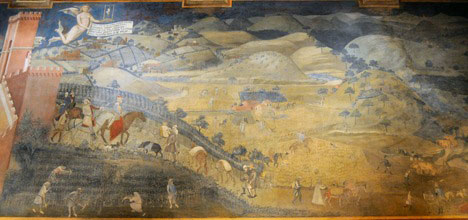
Ambrogio Lorenzetti: 'The Legend of Good and Bad Government (Good Government in the Country)1337-9, Fresco, Sienna.
Painted Space
Like most art historians, Jolly concentrates on de-coding iconography and says little about the composition of pictorial space, usually a figurative artist’s overriding concern. A carefully placed series of spaces, containing other spaces, the pictorial logic holds throughout; it is convincing, rational, planimetric. The Carrel and its contents, including the saint are parallel to the picture plane. It has for example, none of the oddities of later Florentine Mannerism,
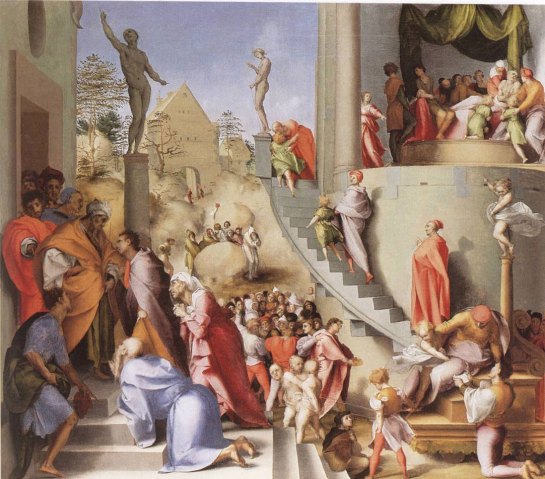
Jacopo Pontormo: 'Joseph with Jacob in Egypt', 1518, oil on panel, 96 x 109 cm. National Gallery, London
try looking at ‘Joseph with Jacob in Egypt’ by Pontormo (expressing perhaps something of the nature of dreams fundamental to the story, certainly of the mysteries of death fundamental to the parts of the story shown here and the style.,
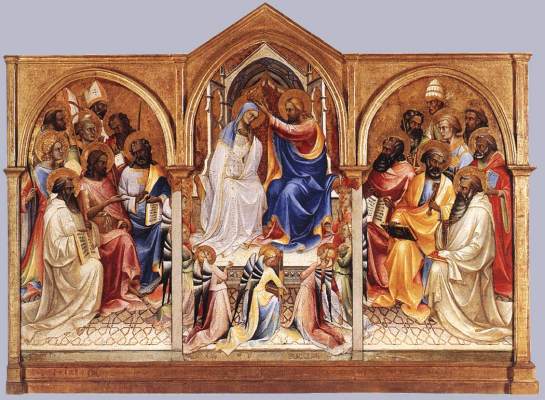
Lorenzo Monaco: 'Coronation of the Virgin', 1414, egg tempera on panel. national Gallery, London
Or the absolute rigidity, pictorial and ideological, of early Renaissance images such as Lorenzo Monaco’s ‘Coronation of the Virgin’. The way each painted area interacts with another is as much part of the meaning as the precise signification of the peacock (“symbol of celestial immortality and incorruptibility” Jolly p 240).
Perec as, I suppose, a Twentieth Century Modernist sees Jerome driving his desk into infinite space, as it were. Doesn’t the composition, with its sequence of steps and arrangement of layers, work the other way?

Antonello da Messina: 'St Jerome in his Study', 1475. oil on panel. 46 x 36 cm. National Gallery, London
Like Jerome, we have to start at the door outside the box, a box we might call home. Note that he has come from outside, he has taken off his hat, his own cap of office, minor officialdom plays no part here. And , we know that he is now on holy ground because, in common with so many other Flemish paintings, he has taken off his shoes. Grasp hold of the significance of these wordly goods, and there are many of them around him, to arrive at the calm centre. We have to examine the objects that make up our ‘home’, study their relationships guided by a key text, before we can look out of the window to paradise.
I try to do this on the train home, but the image of the poor young man, still trying to track down his tent as the batteries fade on his phone, and the monotonous insistence of the red suited would-be sexual athlete who boards the train with me, make looking out of the window in a contemplative mood, difficult.





